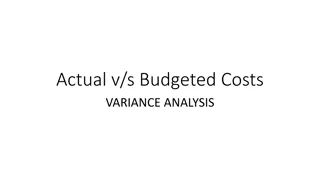Understanding Material Cost Variances in Commerce
Material cost variances play a crucial role in analyzing the differences between actual and standard costs of direct materials used in production. From material cost variances to material price, usage, and mix variances, each aspect sheds light on different aspects of cost control and efficiency in commercial operations.
Download Presentation

Please find below an Image/Link to download the presentation.
The content on the website is provided AS IS for your information and personal use only. It may not be sold, licensed, or shared on other websites without obtaining consent from the author. Download presentation by click this link. If you encounter any issues during the download, it is possible that the publisher has removed the file from their server.
E N D
Presentation Transcript
Teacher:- S.BHATTACHARYYA Dept. of Commerce T H K Jain College
Labour Variances: Types and Formula Material Cost Variances Material Price Variances Material Usage variances Material Mix Variances Material Yield variances
() Material Cost Variance: Material cost variance is the difference between the actual cost of direct material used and standard cost of direct materials specified for the output achieved. This variance results from differences between quantities consumed and quantities of materials allowed for production and from differences between Standard Price And Actual Price. Material cost variance = (SQ X SP) - (AQ X AP) Where SQ = Standard quantity for the actual output SP = Standard price AQ = Actual quantity AP = Actual price
(b) Material Price Variance: Materials price variance = (Actual Price Standard Price) X Actual Quantity Example: Standard Actual Price Rs.10 per kg. Rs. 8 per kg. Quantity 200 kgs. 150 kgs. Ans: Materials price variance = (Standard Price - Actual Price) X Actual Quantity MPV = (10 8) x 150 = 300 (F)
(c) Material Usage Variance The material quantity or usage variance results when actual quantities of raw materials used in production differ from standard quantities that should have been used to produce the output achieved. It is that portion of the direct materials cost variance which is due to the difference between the actual quantity used and standard quantity specified. Materials Usage variance = (Standard Quantity - Actual Quantity) x Standard Price
Materials usage variance Example: Standard material cost per unit: Material A 2 units @ Rs. 10=20 Material B 3 units @ Rs. 20 =60 Units completed 1,000 Actual Materials Used: Material A = 2050 units Material B = 2980 units Ans: Materials Usage variance = (Actual Quantity Standard Quantity) x Standard Price Material A = (2000 2050) x Rs. 10 = Rs. 500 (A) Material B = (3000-2980) x Rs. 20 = Rs. 400 (F) Total = Rs. 100 (A)
(d) Material Mix Variance Materials mix variance is that portion of the materials quantity variance which is due to the difference between the actual composition of a mixture and the standard mixture. Material mix variance = (Standard cost of Actual quantity of the standard mixture Standard cost of Actual Quantity of the actual Mix ) Or, Materials Mix Variance = (Revised Standard Mix of Actual Input Actual Mix) x Standard Price Revised standard mix = (Standard Mix of the Particular Material Total Standard Quantity) X Actual Input
Example: A product is made from two raw materials, material A and material B. One unit of finished product requires 10 kg of material. During a period one unit of product was produced at the following costs:
Ans: Material Mix Variance = (Standard cost of Actual quantity of the standard Mix - Standard cost of Actual Quantity of the Actual Mix ) Material A = (2.4 8) x Rs. 20 = Rs. 112 (A) Material B = (9.6-4) x Rs. 10 = Rs. 56 (F) Total = Rs. 56 (A)
(e)Material Yield Variance It is that portion of materials usage variance which is due to the difference between the actual yield obtained and standard yield specified (in terms of actual inputs). Material Yield Variance = (Standard Yield - Actual yield ) x Standard cost per unit
(e)Material Yield Variance Example: Standard input = 100 kg Standard yield = 90 kg Standard cost per kg of output = Rs 200/ Per Kg Actual input 200 kg Actual yield 182 kg. Ans: Calculation of Material Yield variance: Material Yield Variance = (Standard Yield - Actual yield ) x Standard cost per unit Calculation of Standard Yield = [(Actual Yield X Standard Input) Standard Yield] = [(182 X 100) 90] = 202.22 kg MYV = (202.22 kg 200 kg) X Rs. 200/ per Kg = Rs. 444.44 (F)























